

Jcarafe core assembly 0.9. LingPipe Home. How Can We Help You?
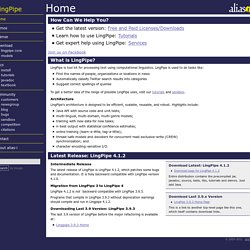
Get the latest version: Free and Paid Licenses/DownloadsLearn how to use LingPipe: Tutorials Get expert help using LingPipe: Services Join us on Facebook What is LingPipe? LingPipe is tool kit for processing text using computational linguistics. LingPipe is used to do tasks like: Find the names of people, organizations or locations in newsAutomatically classify Twitter search results into categoriesSuggest correct spellings of queries To get a better idea of the range of possible LingPipe uses, visit our tutorials and sandbox. Architecture LingPipe's architecture is designed to be efficient, scalable, reusable, and robust.
Stanford Natural Language Processing (NLP) Stanford Named Entity Tagger. GATE.ac.uk - index.html. List of free resources to learn Natural Language Processing - ParallelDots. Natural Language Processing (NLP) is the ability of a computer system to understand human language.
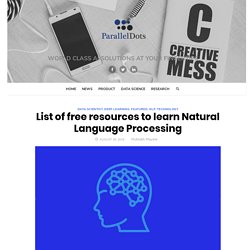
Natural Langauge Processing is a subset of Artificial Intelligence (AI). There are multiple resources available online which can help you develop expertise in Natural Language Processing. In this blog post, we list resources for the beginners and intermediate level learners. Natural Language Resources for Beginners A beginner can follow two methods i.e. Traditional Machine Learning Traditional machine learning algorithms are complex and often not easy to understand. A Review of the Neural History of Natural Language Processing. This is the first blog post in a two-part series.
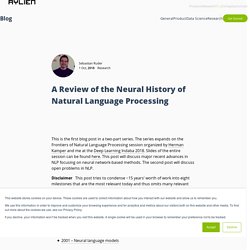
The series expands on the Frontiers of Natural Language Processing session organized by Herman Kamper and me at the Deep Learning Indaba 2018. Slides of the entire session can be found here. The Illustrated BERT, ELMo, and co. (How NLP Cracked Transfer Learning) – Jay Alammar – Visualizing machine learning one concept at a time. The year 2018 has been an inflection point for machine learning models handling text (or more accurately, Natural Language Processing or NLP for short).
Our conceptual understanding of how best to represent words and sentences in a way that best captures underlying meanings and relationships is rapidly evolving. BERT Explained: State of the art language model for NLP. Reflexive hybrid approach to provide precise answer of user desired frequently asked question. Reflexive hybrid approach to provide precise answer of user desired frequently asked question. T-LAB PLUS 2019 - AIDE EN LIGNE - T-LAB Outils pour l'Analyse de Textes. Www.tlab.it Ce que T-LAB fait et ce qu' il vous permet de faire T-LAB est un logiciel composé par un ensemble d'outils linguistiques, statistiques et graphiques pour l'analyse des textes qui peuvent être utilisés dans les pratiques de recherche suivantes: Analyse du Contenu, Sentiment Analysis, Analyse Sémantique, Analyse Thématique,Text Mining, Perceptual Mapping, Analyse du Discours, Network Text Analysis.
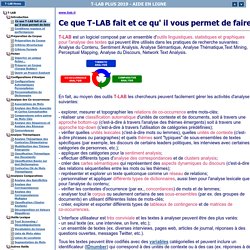
L'interface utilisateur est très conviviale et les textes à analyser peuvent être des plus variés: - un seul texte (ex. une interview, un livre, etc.); - un ensemble de textes (ex. diverses interviews, pages web, articles de journal, réponses à des questions ouvertes, messages Twitter, etc.). Linguistic Rule-Based Ontology-Driven Chatbot System. Computation and Language authors/titles recent submissions. Enseignement. P.
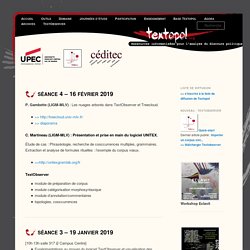
Using NLP to Identify Redditors Who Control Multiple Accounts. Understanding and explaining Delta measures for authorship attribution. Skip to Main Content Sign In Register Close Advanced Search.
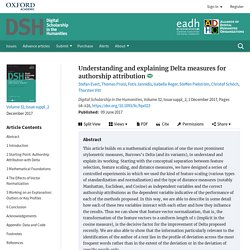
Natural Language Processing is Fun! – Adam Geitgey. This article is part of an on-going series on NLP: Part 1, Part 2, Part 3.
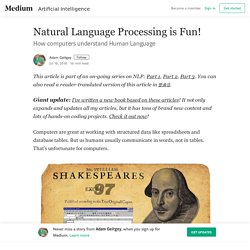
You can also read a reader-translated version of this article in 普通话. Giant update: I’ve written a new book based on these articles! It not only expands and updates all my articles, but it has tons of brand new content and lots of hands-on coding projects. Extraction des informations et des connaissances. Cluster package — NLTK 3.4 documentation. This module contains a number of basic clustering algorithms.
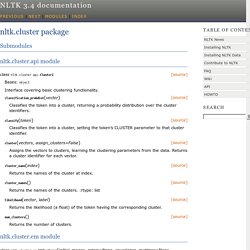
Clustering describes the task of discovering groups of similar items with a large collection. It is also describe as unsupervised machine learning, as the data from which it learns is unannotated with class information, as is the case for supervised learning. Annotated data is difficult and expensive to obtain in the quantities required for the majority of supervised learning algorithms. This problem, the knowledge acquisition bottleneck, is common to most natural language processing tasks, thus fueling the need for quality unsupervised approaches.
This module contains a k-means clusterer, E-M clusterer and a group average agglomerative clusterer (GAAC). The K-means clusterer starts with k arbitrary chosen means then allocates each vector to the cluster with the closest mean. The GAAC clusterer starts with each of the N vectors as singleton clusters. Semantics, not syntax, creates NLU – Pat Inc. A scientific hypothesis starts the process of scientific enquiry.
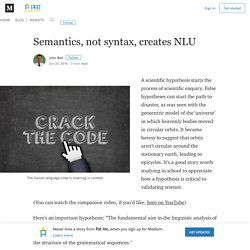
False hypotheses can start the path to disaster, as was seen with the geocentric model of the ‘universe’ in which heavenly bodies moved in circular orbits. It became heresy to suggest that orbits aren’t circular around the stationary earth, leading to epicycles. It’s a good story worth studying in school to appreciate how a hypothesis is critical to validating science. (You can watch the companion video, if you’d like, here on YouTube) Here’s an important hypothesis: “The fundamental aim in the linguistic analysis of a language L is to separate the grammatical sequences which are the sentences of L from the ungrammatical sequences which are not sentences of L and to study the structure of the grammatical sequences.”
Report on Text Classification using CNN, RNN & HAN – Jatana. Introduction Hello World!!
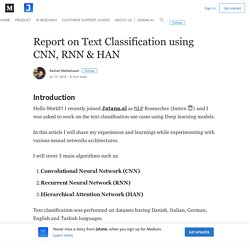
I recently joined Jatana.ai as NLP Researcher (Intern 😇) and I was asked to work on the text classification use cases using Deep learning models. In this article I will share my experiences and learnings while experimenting with various neural networks architectures. L’avenir de la programmation : le langage naturel. Pour le pionnier de l’informatique, Alan Turing, l’intelligence artificielle triompherait lorsqu’un programme informatique réussirait à convaincre un interlocuteur qu’il était humain. C’est le fameux « test de Turing » qu’aucune machine n’a réussi à passer depuis – même si plusieurs « agents conversationnels » s’en sont approchés.
Reconnaissance et génération d'humour : comment faire bien placer les "that's what she said!" à un ordi. How we improved NLP error rate fourfold and achieved 94% accuracy. The Essential NLP Guide for data scientists (codes for top 10 NLP tasks) NLTK Book. Natural Language Processing with Python – Analyzing Text with the Natural Language Toolkit Steven Bird, Ewan Klein, and Edward Loper This version of the NLTK book is updated for Python 3 and NLTK 3.
The first edition of the book, published by O'Reilly, is available at (There are currently no plans for a second edition of the book.) 0. 1. 2. 3. 4. 5. 6. 7. 8. 9. Thomas Solignac simplifie les algorithmes de langage naturel. Un scientifique contrarié : c'est ainsi que se présente Thomas Solignac, 26 ans. « Je suis passionné d'astrophysique depuis toujours. Mais l'enseignement des sciences m'est apparu très froid par rapport à mes attentes. J'étais aussi porté sur la philosophie, et j'ai dû faire un choix », évoque le cofondateur de Golem.ai. Ce sera donc les sciences : en 2010, il intègre Epitech, une école parisienne d'informatique.
Mais il n'abandonne pas pour autant son deuxième amour, la philosophie, et suit des cours à distance à la faculté de Nanterre (Hauts-de-Seine). À Epitech, il intègre dès sa première année une association de robotique et le laboratoire d'intelligence artificielle.